Rural Scotland: key facts 2018
Biennial compendium publication comparing and contrasting statistics on key policy topics such as People and Communities, Services and Lifestyle, Economy and Enterprise broken down by Remote Rural, Accessible Rural and the Rest of Scotland.
Services and Lifestyle
Access and Convenience of Services
Figure 7: Percentage within 15 minute drive time of service by geographic area, 2016
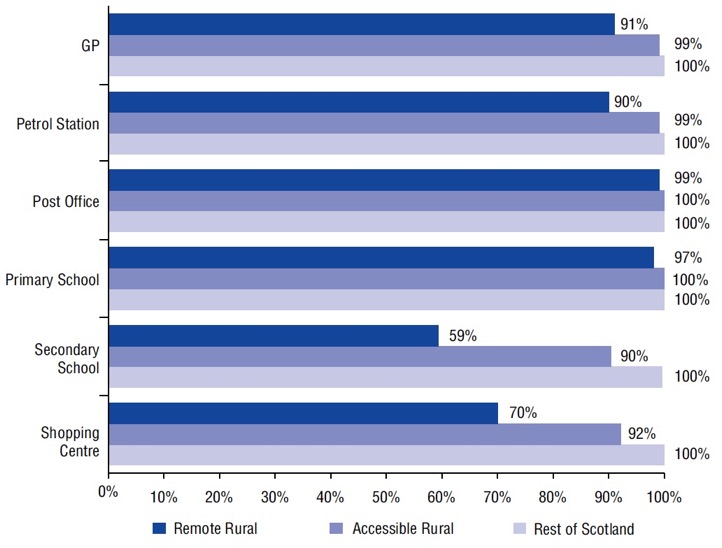
Source: Scottish Index of Multiple Deprivation 2016 (Using Scottish Government Urban Rural Classification 2016)
Figure 7 shows that only rural areas of Scotland are not within a 15 minute drive time to key services. For example 91% of people in remote rural areas and 99% of people in accessible rural areas live within a 15 minute drive time to a GP compared to 100% of the population in the rest of Scotland.
The greatest difference observed in drive time is to the nearest secondary school. In remote rural areas, 59% people live within a 15 minute drive time to a secondary school, compared to 90% of people in accessible rural areas and 100% of people in the rest of Scotland.
There is also a noticeable difference in observed drive time to the nearest shopping centre in rural Scotland compared to the rest of Scotland. While 100% of people in the rest of Scotland live within a 15 minute drive time to a shopping centre, only 70% of people in remote rural areas do. This rises to 92% in accessible rural areas.
Figure 8: Percentage of population within 15 minute drive time by public transport of service, by geographic area, 2016
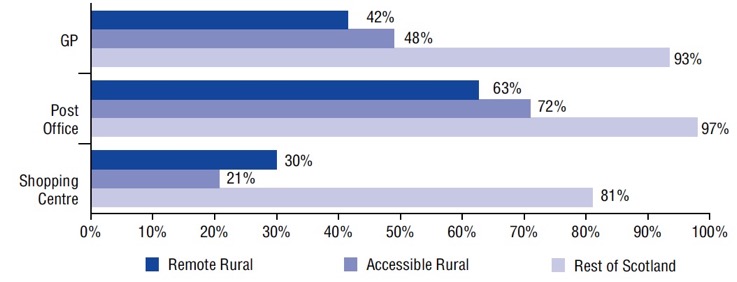
Source: Scottish Index of Multiple Deprivation 2016 (Using Scottish Government Urban Rural Classification 2016)
Figure 8 shows that the proportion of people within a 15 minute drive time to key services by public transport is much lower in both remote rural and accessible rural areas compared to the rest of Scotland. The figures are particularly low in rural areas with respect to drive time to the nearest shopping centre, where only 30% of people in remote rural areas live within a 15 minute drive. The proportion is even lower at 21% in accessible rural areas.
Less than half of people living in rural areas of Scotland live within a 15 minute drive time to a GP by public transport, with only around two thirds of people in rural Scotland within a 15 minute drive time by public transport to a post office.
Figure 9: Percentage finding services very or fairly convenient by geographic area, 2016
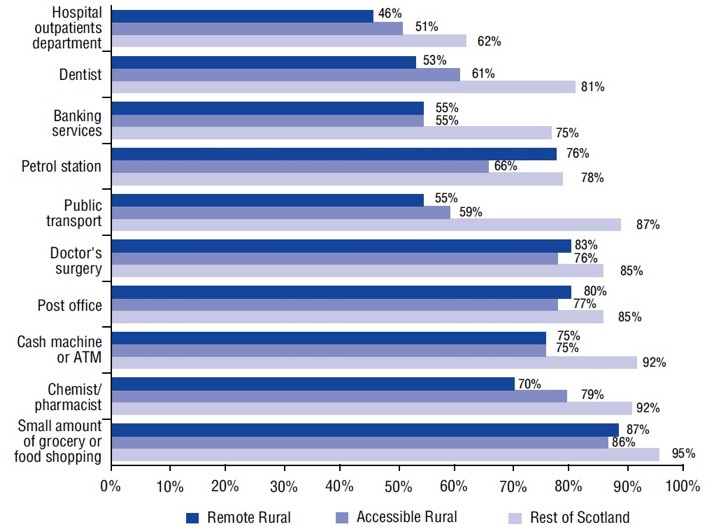
Source: Scottish Household Survey 2016 (Using Scottish Government Urban Rural Classification 2016)
Figure 9 shows that, in general, a lower percentage of people in rural areas find key services convenient, when compared to the rest of Scotland. This is particularly noticeable for key services such as hospitals, dentists, chemists, public transport, banking services and cash machines. For example, 53% of residents of remote rural areas find the nearest dentist convenient, compared to 81% of rest of Scotland residents.
The greatest differences in the proportion of people finding services ‘very or fairly convenient’ between remote rural and accessible rural areas and the rest of Scotland is for public transport. In remote rural and accessible rural areas respectively 55% and 59% find public transport convenient compared to 87% in the rest of Scotland. This is also reflected in Figure 10, which shows the level of satisfaction with the quality of public transport services.
In all areas of Scotland the key service that is rated by the lowest proportion of people as being convenient is hospital outpatient departments. With only around half of people in rural Scotland rating them as ‘very or fairly convenient’ and 62% in the rest of Scotland.
Figure 10: Satisfaction with the quality of public transport services delivered by geographic area, 2017
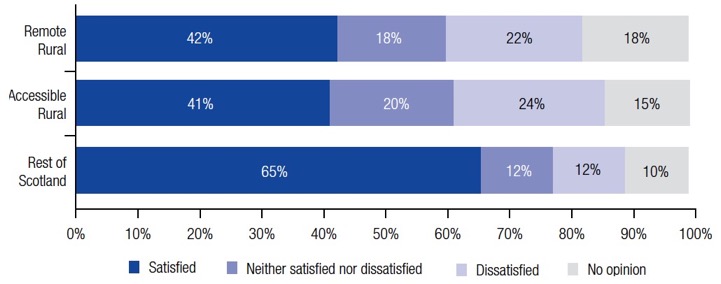
Source: Scottish Household Survey 2017 (Using Scottish Government Urban Rural Classification 2016)
Figure 10 shows that 22% and 24% respectively of the population in remote and accessible rural areas are ‘dissatisfied’ with the quality of public transport service delivered in their area. This compares to only 12% of the population in the rest of Scotland.
The opposite is true for those that are ‘satisfied’ with quality of public transport service delivered in their area. In the rest of Scotland 65% of the population are ‘satisfied’ compared to 42% and 41% in remote and accessible rural areas.
Table 11: Households with home internet access by geographic area, 2017
Remote Rural |
Accessible Rural |
Rest of Scotland |
|
|---|---|---|---|
Yes |
86% |
85% |
85% |
No |
14% |
15% |
15% |
Don't know |
- |
- |
0% |
All |
100% |
100% |
100% |
Source: Scottish Household Survey 2017 (Using Scottish Government Urban Rural Classification 2016)
From Table 11, it can be seen that the proportion of households with home internet access is very similar across all areas of Scotland. With the proportion of households in remote rural areas being marginally higher at 86% compared to 85% in both accessible rural areas and the rest of Scotland.
Table 12: How households1 with internet access connect to the internet by geographic area, 2017
Remote Rural |
Accessible Rural |
Rest of Scotland |
|
|---|---|---|---|
DSL broadband (via your phone line) |
83% |
77% |
56% |
Superfast broadband via cable, optical fibre, Ethernet etc. (e.g. Virgin Media, BT Infinity) |
11% |
15% |
33% |
Broadband via satellite, public Wi-Fi |
4% |
5% |
9% |
Mobile broadband via mobile phone network (at least 3G or 4G) via a mobile phone or smartphone |
4% |
7% |
14% |
Mobile broadband via mobile phone network (at least 3G or 4G) via dongle or card |
2% |
2% |
1% |
Dial-up access over a normal telephone line or ISDN |
- |
0% |
0% |
Other |
1% |
2% |
1% |
Source: Scottish Household Survey 2017 (Using Scottish Government Urban Rural Classification 2016)
Notes: 1. Households can connect to the internet via multiple ways.
Of those households with home internet access, almost all of them have a broadband connection through either Digital Subscriber Line (DSL) broadband or an Ethernet etc. connection. This is true for all areas of Scotland but there is a much higher proportion of households in the rest of Scotland (33%) that connect to the internet via an Ethernet etc. connection compared to remote rural (11%) and accessible rural (15%) areas.
Connecting to the internet using a mobile broadband via mobile phone network (via a mobile phone or smartphone) is also much more prevalent in the rest of Scotland than in rural areas.
These figures do not reflect the actual availability of broadband across Scotland and in particular in rural Scotland. Through the ‘Reaching 100%’[3] (R100) commitment, the Scottish Government wants every home and business in Scotland to have access to superfast broadband by 2021. With superfast broadband meaning speeds greater than 30 Mbps. The report ‘UK home broadband performance, November 2017’[4] published by Ofcom in May 2018 shows that Scotland currently has the lowest average rural download speed recorded among the four UK nations.
The Scottish Government has a National Indicator[5] to increase access to superfast broadband.
Table 13: Methods used to dispose of food waste1 by geographic area, 2017
Remote Rural |
Accessible Rural |
Rest of Scotland |
|
|---|---|---|---|
General waste with other rubbish |
63% |
49% |
47% |
Local Authority provided caddy or other receptacle |
27% |
47% |
59% |
Home composting e.g. Heap in garden or allotment, green cone |
22% |
18% |
7% |
Source: Scottish Household Survey 2017 (Using Scottish Government Urban Rural Classification 2016)
Notes: 1. Respondents can choose more than one option.
Table 13 shows that households in rural areas are more likely to dispose of food by home composting compared to the rest of Scotland, with the highest proportion in remote rural areas.
In contrast, the rest of Scotland shows the highest proportion of households that will dispose of food waste by means of a local authority provided caddy or other receptacle, with over half of households using this disposal method. This compares to around a quarter in remote rural areas.
In remote rural areas the highest proportion of households (63%) dispose of food waste in their general waste with other rubbish, while the proportions in accessible rural areas and the rest of Scotland are similar at just under 50%.
Travel Patterns
Table 14: Cars normally available for private use by geographic area, 2017
Remote Rural |
Accessible Rural |
Rest of Scotland |
|
|---|---|---|---|
None |
13% |
12% |
31% |
One |
43% |
42% |
43% |
Two or more |
44% |
47% |
26% |
Total |
100% |
100% |
100% |
Source: Scottish Household Survey 2017 (Using Scottish Government Urban Rural Classification 2016)
Table 14 shows that households in rural Scotland are more likely to have access to at least one car, than households in the rest of Scotland. With the highest proportion of households with access to two or more cars being in accessible rural areas.
That a higher proportion of households in rural areas have access to at least one cars is perhaps a reflection of the longer journey times to key services by public transport as reported in Figure 8 or the lower proportion of people in rural areas that are satisfied with the quality of public transport services that are delivered (Figure 10).
Table 15: How adults usually travel to work/education by geographic area, 2017
Remote Rural |
Accessible Rural |
Rest of Scotland |
|
|---|---|---|---|
Walking |
11% |
5% |
13% |
Driver of a car or van |
78% |
77% |
59% |
Passenger in a car or van |
2% |
4% |
6% |
Bicycle |
1% |
1% |
3% |
Bus (ordinary or works) |
5% |
6% |
11% |
Rail |
1% |
4% |
6% |
Other |
3% |
3% |
2% |
Total |
100% |
100% |
100% |
Source: Scottish Household Survey 2017 (Using Scottish Government Urban Rural Classification 2016)
Table 15 shows that people in rural areas are more likely to drive to work/education and less likely to take public transport, compared to the rest of Scotland.
In 2007, the Scottish Government introduced a National Indicator[6] to increase the proportion of journeys to work made by public or active transport.
Table 16: How school children normally travel to school by geographic area, 2017
Remote Rural |
Accessible Rural |
Rest of Scotland |
|
|---|---|---|---|
Walking/bicycle |
32% |
25% |
58% |
Passenger in a car/van |
25% |
33% |
25% |
Bus (ordinary, school, works, or private) |
40% |
38% |
16% |
Other |
3% |
4% |
2% |
Total |
100% |
100% |
100% |
Source: Scottish Household Survey 2017 (Using Scottish Government Urban Rural Classification 2016)
Table 16 shows that children in rural areas are more likely to travel to school by bus than by any other mode of transport, whereas children in the rest of Scotland are more likely to walk or cycle.
Figure 7 shows that a greater proportion of children living in rural areas are outwith 15 minutes drive to primary schools and in particular, secondary schools. This is likely to have an impact on the lower proportion of children in rural areas that normally either walk or cycle to school.
Figure 11: Distance to work1 for people aged over 16 in employment by geographic area, 2015-2017
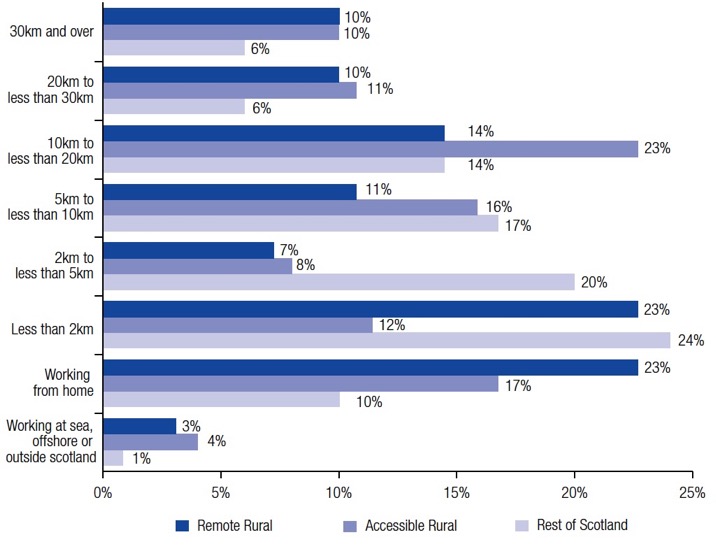
Source: Scottish Household Survey 2015, 2016 and 2017 (Using Scottish Government Urban Rural Classification 2016)
Notes: 1. The distance to work is a calculation of the straight line between the postcode of place of residence and postcode of workplace.
The highest proportion of people living in remote rural areas travel less than 2 km to work (23%). This is also the case in the rest of Scotland where 24% of people travel less 2 km to work (24%). This compares to 11% in accessible rural areas.
In remote rural areas a high proportion of people also work at home (22%). The proportion of people working at home is lower in accessible rural areas (17%) and lower still for people in the rest of Scotland (10%).
In accessible rural areas the highest proportion of people travel between 10 km and 20 km to work (24%). This compares to 14% in both remote rural areas and the rest of Scotland.
Just over a third of people living in accessible rural areas travel between 10 km and 30 km to work. As accessible rural areas are within a drive time of 30 minutes to the nearest settlement with a population of 10,000 or more, this could indicate that people living in accessible rural areas are commuting to urban areas to work.
Figure 12: Total expenditure on fuel for cars per month by geographic area, 2017
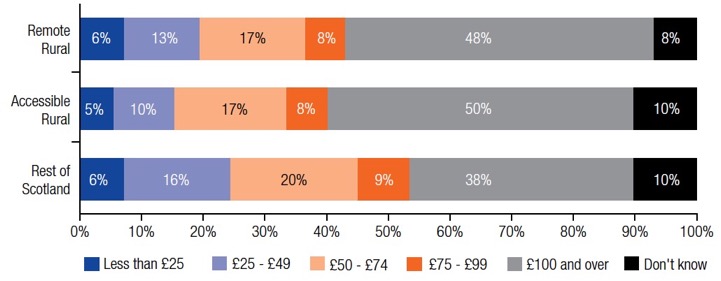
Source: Scottish Household Survey 2017 (Using Scottish Government Urban Rural Classification 2016)
Figure 12 shows that residents in rural Scotland are more likely than those in the rest of Scotland to spend over £100 per month on fuel for their cars. The proportion of residents of remote rural and accessible rural areas that report that they spend over £100 per month of fuel is around half, compared to 38% in the rest of Scotland. A higher level of expenditure on fuel for cars is likely to be, in part, due to longer driving distances to key services, as shown in Figure 7.
Education
Table 17: Highest qualifications held by population aged 16 to 64 by geographic area, 2017
Remote Rural |
Accessible Rural |
Rest of Scotland |
|
|---|---|---|---|
Degree Level or Equivalent |
24% |
31% |
30% |
HNC/HND or equivalent |
16% |
17% |
15% |
Higher/A-Level or equivalent |
24% |
23% |
23% |
Credit Standard Grade or equivalent |
19% |
18% |
17% |
General Standard Grade or equivalent |
4% |
1% |
2% |
Other |
4% |
3% |
5% |
No Qualifiactions |
8% |
7% |
9% |
Total |
100% |
100% |
100% |
Source: Annual Population Survey in Scotland, January to December 2017 (Using Scottish Government Urban Rural Classification 2016)
Table 17 shows that levels of school and college education attained are broadly comparable for accessible rural areas and the rest of Scotland. The highest qualifications held by the population in remote rural areas are slightly different. In particular, there are a lower proportion of residents of remote rural areas that have a degree level qualification or equivalent compared to accessible rural areas and the rest of Scotland.
The proportion of people with a General Standard Grade or equivalent qualification as their highest is slightly higher in remote rural areas (4%) compared to accessible rural areas and the rest of Scotland (1% and 2% respectively).
It should be noted that the information in this table may reflect where people choose to live after achieving their qualifications, rather than reflecting attainment by those initially living in rural areas.
Table 18: Destination of school leavers from publicly funded secondary schools by geographic area, 2016-17
Remote Rural |
Accessible Rural |
Rest of Scotland |
|
|---|---|---|---|
Positive Destinations |
96% |
95% |
92% |
Higher Education |
38% |
41% |
38% |
Further Education |
19% |
21% |
24% |
Training |
1% |
1% |
2% |
Employment |
36% |
31% |
27% |
Voluntary Work |
0% |
1% |
1% |
Activity Agreement |
1% |
1% |
1% |
Other destinations |
4% |
5% |
8% |
Unemployed Seeking |
2% |
3% |
5% |
Unemployed Not Seeking |
2% |
2% |
2% |
Unknown |
1% |
0% |
1% |
Source: Destination of Leavers from Scottish Schools 2016-17 (Based on school leaver’s home address and Scottish Government Urban Rural Classification 2016)
Table 18 shows the proportion of school leavers who proceed to higher education is very similar across all three areas of Scotland. Although the proportion is slightly higher in accessible rural areas at 41% compared to 38% in both remote rural areas and the rest of Scotland.
Fewer school leavers in remote rural areas go on to further education compared to school leavers in accessible rural areas and the rest of Scotland.
A higher proportion of school leavers in remote rural areas (36%) go straight into employment compared to accessible rural areas (31%) and the rest of Scotland (27%).
The highest proportion of school leavers that are unemployed and seeking work are in the rest of Scotland (5%). This is marginally higher than the 3% in accessible rural areas and the 2% in remote rural areas. The proportion of school leavers that are unemployed and not seeking work is the same across all areas of Scotland at 2%.
Health
Figure 13: Life expectancy at birth by geographic area, 2014-2016
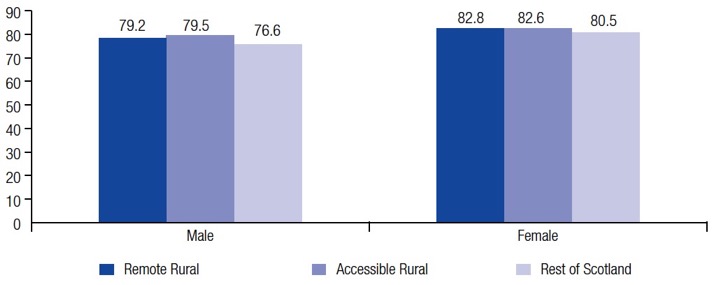
Source: Life Expectancy Statistics, National Records of Scotland (Using Scottish Government Urban Rural Classification 2016)
Figure 13 shows that the life expectancy in remote rural and accessible rural areas is around 79 years for males, nearly three years more than in rest of Scotland. For females, the life expectancy in rural areas is almost 83 years, which is slightly more than two years higher than in the rest of Scotland. It should be noted that there is an overall increasing trend in life expectancy at birth for both males and females in Scotland.
In all areas of Scotland, the life expectancy of females is higher than that of males. The largest difference in life expectancy between males and females is for the rest of Scotland (3.9 years). Overall, the life expectancy of people born in rural Scotland is higher than in the rest of Scotland. It is highest for males in remote rural areas but in accessible rural areas for females.
Table 19: Rate of hospital admissions (emergency and cancer) by geographic area, 2017
Remote Rural |
Accessible Rural |
Rest of Scotland |
|
|---|---|---|---|
Emergency admissions rate per 100,000 population |
9,163 |
9,365 |
10,921 |
Cancer admissions rate per 100,000 population |
3,424 |
3,396 |
3,518 |
Source: Information Services Division, NHS Scotland (Using Scottish Government Urban Rural Classification 2016)
Table 19 shows that the highest rates per 100,000 population for both emergency and cancer admissions were in the rest of Scotland in 2017. The lowest rate per 100,000 population for emergency admissions was in remote rural areas but for cancer admissions it was in accessible rural areas. Across all areas of Scotland the emergency admission rate is around three times the cancer admission rate.
Please not that these data are not adjusted to account for the different age profiles (see Figure 2) which would affect admission rates.
Table 20: Whether respondent smokes by geographic area, 2017
Remote Rural |
Accessible Rural |
Rest of Scotland |
|
|---|---|---|---|
Yes |
18% |
14% |
18% |
No |
82% |
86% |
82% |
Total |
100% |
100% |
100% |
Source: Scottish Household Survey 2017 (Using Scottish Government Urban Rural Classification 2016)
Table 20 shows that the highest proportion of smokers are in remote rural areas and the rest of Scotland smoke, with 18% of people being smokers. The smoking proportion drops to 14% in accessible rural areas. Overall this means that less than one in five people in Scotland are smokers.
Housing
Figure 14: Property type by geographic area, 2017
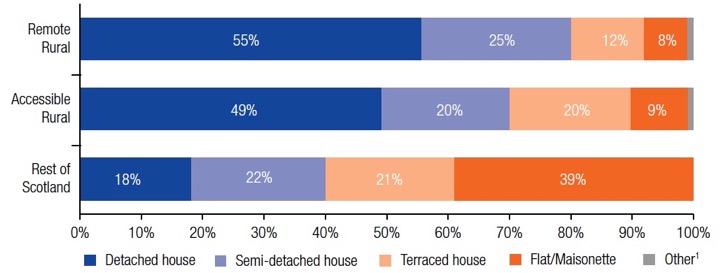
Source: Scottish Household Survey 2017 (Using Scottish Government Urban Rural Classification 2016)
Notes: 1. Other includes caravans, mobile homes and houseboats as well as other kinds of accommodation.
Figure 14 shows that 92% of properties in remote rural areas are houses or bungalows, more than half of which are detached. The profile is similar in accessible rural areas, with a slightly higher prevalence of terraced houses and a lower prevalence of detached and semi-detached housing.
In contrast, in the rest of Scotland flats account for 39% of the housing stock, with the remaining 61% being split relatively evenly between detached, semi-detached and terraced houses. In the rest of Scotland the smallest proportion of the housing stock are detached properties (18%).
Table 21: House sales1 by geographic area, 2017
Remote Rural |
Accessible Rural |
Rest of Scotland |
|
|---|---|---|---|
Number of Sales |
4,941 |
10,449 |
74,185 |
Change from 2016 |
5% |
7% |
5% |
Mean Price |
£182,888 |
£211,288 |
£174,106 |
Change from 2016 |
4% |
2% |
4% |
Median Price |
£163,000 |
£187,000 |
£146,111 |
Change from 2016 |
4% |
1% |
4% |
Source: Registers of Scotland (Using Scottish Government Urban Rural Classification 2016)
Notes: 1. These figures cover sales of new build houses and market sales from one person to another for prices between £20,000 and £1,000,000. Other sales have been excluded as these may be non-market sales or may have a large impact on the mean sale price. An urban rural classification was assigned to around 98% of sales. The 2% (2,039 records) for which it was not possible to assign an urban rural classification have been excluded from all figures
Table 21 shows that the highest mean price in 2017, based on actual house sales, was £211,288 in accessible rural areas, £28,400 higher than in remote rural areas and almost £37,200 higher than in the rest of Scotland. The highest median price was also in accessible rural areas. The difference in the median price between remote and accessible rural areas was less than the mean price but for accessible rural areas and the rest of Scotland this difference was larger. This indicates some higher priced house sales are having a large effect on the mean house price in the rest of Scotland.
Compared to 2016 there was a higher increase in mean house prices in remote rural areas and the rest of Scotland (an increase of 4% for both) than in accessible rural areas (2% increase).
In all areas of Scotland more house sales took place in 2017 than in 2016, with the largest increase taking place in accessible rural areas (7%). This compares to a 5% increase in both remote rural areas and the rest of Scotland.
Please note the prices do not necessarily compare like with like as prices are not adjusted for property type and size (Figure 14 shows the differences in property types by geographic area).
Figure 15: Housing tenure1 by geographic area, 2017
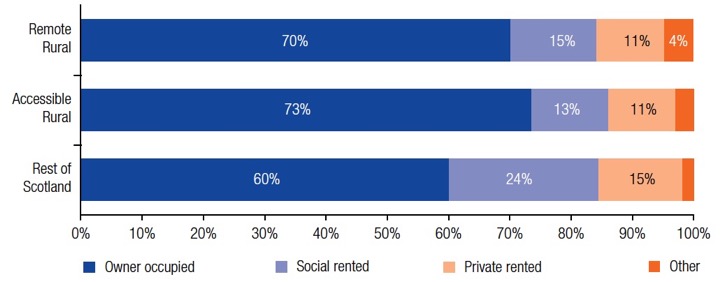
Source: Scottish Household Survey 2017 (Using Scottish Government Urban Rural Classification 2016)
Notes: 1. A description of housing tenure can be found under Definitions in the Notes section at the back of this booklet.
Figure 15 shows that compared with the rest of Scotland, a higher proportion of households in rural Scotland are owner occupied (70% and 73% respectively in remote rural and accessible rural areas, compared with 60% in the rest of Scotland) and a smaller proportion rent from local authorities or housing associations (15% in remote rural areas and 13% in accessible rural areas, compared with 24% in the rest of Scotland). The rate of private renting is higher in the rest of Scotland at 15% compared to 11% in both remote and accessible rural areas.
Table 22: Use of housing stock by geographic area, 2017
Remote Rural |
Accessible Rural |
Rest of Scotland |
|
|---|---|---|---|
% Vacant dwellings1 |
3% |
5% |
3% |
% Second homes2, 3 |
1% |
7% |
0% |
% Dwellings with a single adult discount4 |
29% |
30% |
39% |
Source: Estimates of households and dwellings in Scotland 2017, National Records of Scotland (Using Scottish Government Urban Rural Classification 2016)
Notes:
1. Vacant dwellings include dwellings which are unoccupied and long term empty properties.
2. Second home figures were not available for Aberdeen City, City of Edinburgh and West Dunbartonshire for 2017. The 2016 totals were used instead.
3. Second homes are dwellings subject to a Council Tax classification as such (including self-catering holiday accommodation available to let for a total of less than 140 days per year).
4. Dwellings with a single adult discount include dwellings with a single adult, one adult living with one or more children, or adults who are ‘disregarded’ for Council Tax purposes.
Table 22 shows the percentage of vacant dwellings, those occupied as second homes and those eligible for Council Tax single adult discount. The largest proportion of second homes is in accessible rural areas with 7% of dwellings being used as second homes. While in remote rural areas 1% are second homes and in the rest of Scotland it is less than 0.5%.
The rest of Scotland has the largest proportion (39%) of single adult households with remote rural areas having 29% and accessible rural areas having 30% of dwellings with just one adult resident.
The number of vacant dwellings is slightly higher in accessible rural areas (5%) than in remote rural areas and the rest of Scotland (both 3%).
Table 23: Energy Performance Certificate1 rating by geographic area, 2016
Remote Rural |
Accessible Rural |
Rest of Scotland |
|
|---|---|---|---|
BC (69-91) |
11% |
25% |
43% |
D (55-68) |
33% |
36% |
45% |
E (39-54) |
30% |
27% |
10% |
FG (1-38) |
25% |
12% |
2% |
Mean SAP 2012 Rating |
50 |
57 |
66 |
Median SAP 2012 Rating |
53 |
59 |
67 |
Source: Scottish House Condition Survey 2016 (Using Scottish Government Urban Rural Classification 2016)
Notes: 1. For Energy Efficiency Ratings (EERs), band A represents high energy efficiency, while band G denotes low energy efficiency. A full description of Energy Performance Certificates (EPC) and EERs can be found under Definitions in the Notes section at the back of this booklet.
2. No A-rated (92-100) dwellings were sampled.
Table 23 shows that the housing stock in rural Scotland is generally less energy efficient than in the rest of Scotland. In remote rural areas, the median energy efficient rating is 53 compared to 59 in accessible rural areas and 67 in the rest of Scotland. Despite the difference in the actual median ratings, the housing stock in accessible rural areas and the rest of Scotland would still be given a band D for their Energy Performance Certificate (EPC), while the housing stock in remote rural areas would be in the lower band E.
A higher proportion of the housing stock in rural areas are in the lower bands (F and G) than in the rest of Scotland. In remote rural areas it is 25% and in accessible rural areas it is 12%. This compares to only 2% of the housing stock in the rest of Scotland.
Figure 16: Fuel poverty by geographic area, 2016
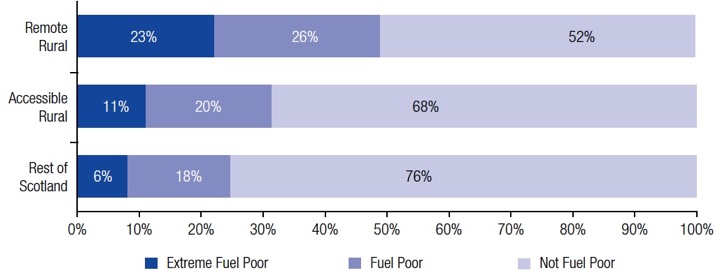
Source: Scottish House Condition Survey 2016 (Using Scottish Government Urban Rural Classification 2016)
A household is defined as being in fuel poverty if it would be required to spend more than 10% of its income (including Housing Benefit or Income Support for Mortgage Interest) on all household fuel use. ‘Extreme fuel poverty’ is defined as a household having to spend more than 20% of its income on household fuel.
Figure 16 shows that the proportion of households in remote rural areas which are classed as extreme fuel poor is more than double that of the proportion in accessible rural areas (22% compared to 9%) While compared to the rest of Scotland the proportion in remote rural areas is almost four times as high (23% compared to 6%).
Almost half of households in remote rural areas are classed as ‘fuel poor’, while nearly a third of households in accessible rural areas are in fuel poverty. In contrast, in the rest of Scotland, 76% of households have been classed as ‘not fuel poor’.
Figure 17: Presence of condensation, damp and urgent disrepair by geographic area, 2016
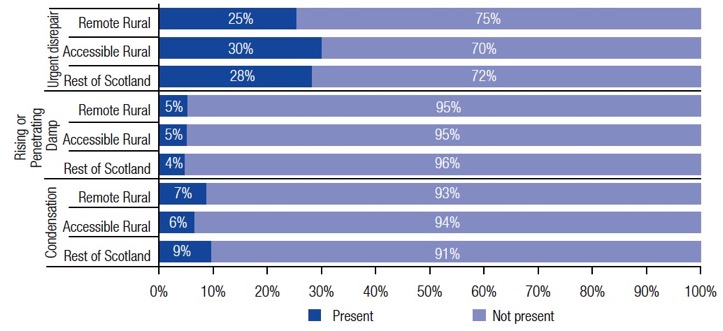
Source: Scottish House Condition Survey 2016 (Using Scottish Government Urban Rural Classification 2016)
Figure 17 shows the level of urgent disrepair is highest amongst homes in accessible rural areas (30%) and lowest in remote rural areas (25%). Urgent disrepair relates to levels of disrepair requiring immediate repair to prevent further damage or health and safety risk to occupants. Urgency of disrepair is only assessed for external and common elements.
Overall the proportion of homes affected by either rising or penetrating damp or condensation are lower than those in urgent disrepair. In both remote and accessible rural areas, 5% of homes are affected by rising or penetrating damp. In the rest of Scotland it is 4% of homes.
The highest proportion of homes affected by condensation are in the rest of Scotland (9%). The proportion of homes are slightly lower in both remote rural and accessible rural areas (respectively 7% and 6%).
Table 24: Presence of loft insulation in homes by geographic area, 2016
Remote Rural |
Accessible Rural |
Rest of Scotland |
|
No loft insulation |
1% |
1% |
0% |
Less than 100mm |
4% |
5% |
6% |
100mm to 199mm |
30% |
28% |
28% |
200mm to 199mm |
30% |
34% |
35% |
300 or more |
34% |
32% |
29% |
Total |
100% |
100% |
100% |
Source: Scottish House Condition Survey 2016 (Using Scottish Government Urban Rural Classification 2016)
Table 24 illustrates the prevalence and thickness of loft insulation. Only 1% of houses in remote rural and accessible rural areas that have lofts have no loft insulation, while less than 0.5% of homes in the rest of Scotland have no loft insulation.
For all areas of Scotland, approaching one third of properties with lofts have insulation of between 100 mm and 199 mm. Around a third of homes have between 200 mm and 299 mm of loft insulation, while around another third have insulation of 300 mm or more. This shows that now the majority of properties have some loft insulation, the trend is to have a greater thickness of loft insulation.
Contact
Neil Henderson: RuralStatistics@gov.scot
There is a problem
Thanks for your feedback